 W
WCookware and bakeware is food preparation equipment, such as cooking pots, pans, baking sheets etc. used in kitchens. Cookware is used on a stove or range cooktop, while bakeware is used in an oven. Some utensils are considered both cookware and bakeware.
 W
WA baking stone is a portable cooking surface used in baking. It may be made of ceramic, stone or, more recently, salt. Food is put on the stone, which is then placed in an oven, though sometimes the stone is heated first. Baking stones are used much like cookie sheets, but may absorb additional moisture for crispier food. A pizza stone is a baking stone designed for cooking pizza.
 W
WA bread pan, also called a loaf pan, is a kitchen utensil in the form of a container in which bread is baked. Its function is to shape bread while it is rising during baking. The most common shape of the bread pan is the loaf, or narrow rectangle, a convenient form that enables uniform slicing. The bread pan is made from a conductive material such as metal which might be treated with a non-stick coating. It can also be made of heat-resistant glass, ceramic, or a special type of paper that sticks to the dough but is easily removed, once cooked. Bread pans are found in a variety of designs and sizes providing the baker with different possibilities not only for baking bread, but also cakes and puddings.
 W
WA brustolina is a grill which fits over a gas burner on a hob. It consists of a square sheet of metal with holes punched in it and a square grid over the top. Heat is applied from below and is evenly distributed by the base, deflected upward to the grid. Items placed on top of the grid are cooked by both convection and radiant heat. These versatile cooking devices are often used in preparation of Italian cuisine, for instance, grilling bruschetta, polenta or vegetables. They are economical and widely available on street markets in Italy.
 W
WA Bundt cake is a cake that is baked in a Bundt pan, shaping it into a distinctive doughnut shape. The shape is inspired by a traditional European cake known as Gugelhupf, but Bundt cakes are not generally associated with any single recipe. The style of mold in North America was popularized in the 1950s and 1960s, after cookware manufacturer Nordic Ware trademarked the name "Bundt" and began producing Bundt pans from cast aluminum. Publicity from Pillsbury saw the cakes gain widespread popularity.
 W
WA chafing dish is a metal cooking or serving pan on a stand with an alcohol burner holding chafing fuel below it. It is used for cooking at table, notably in Gueridon service, or as a food warmer for keeping dishes at a buffet warm.
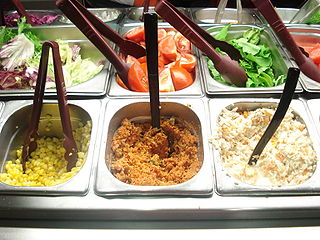 W
WGastronorm (GN), sometimes spelled Gastro-Norm, is a European standard for kitchenware tray and container sizes that is commonly seen worldwide in the catering and professional food industry, as well as in certain parts of the high-end consumer market. Gastronorm is generally used worldwide except in the United States, which has its own domestic system. The gastronorm standard was first introduced in Switzerland in 1964 and became an official European standard in 1993 with the EN 631 standard.
 W
WGrab-Its are microwave-safe cookware easily identifiable by their tab handle. They were introduced by Corning Glass Works in 1977, under the Corning Ware brand and are now sold in a slightly different form by Corelle Brands. Grab-Its are notable as being among the first cookware specifically designed for microwave use - their design was recognized by the Smithsonian's Cooper-Hewitt, National Design Museum. Grab-Its strongly resemble porringers.
 W
WA griddle is a cooking device consisting of a broad flat surface heated by gas, electricity, wood, or coal, with both residential and commercial applications. In industrialized countries, a griddle is most commonly a flat metal plate, elsewhere typically a brick slab or tablet.
 W
WA gridiron is a metal grate with parallel bars typically used for grilling meat, fish, vegetables, or combinations of such foods. It may also be two such grids, hinged to fold together, to hold food securely while grilling over an open flame.
 W
WMakiyakinabe are square or rectangular cooking pans used to make Japanese-style rolled omelettes. The pans are commonly made from metals such as copper and tin, and can also be coated with a non-stick surface. Dimensions and proportions of the pan vary among regions of Japan, but it is always rectangular. Rolled omelettes made with makiyakinabe are commonly used as a side dish in sushi and bentō.
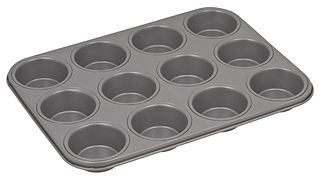 W
WA muffin or cupcake tray is a mold in which muffins or cupcakes are baked. A single cup within a regular muffin tin is 100 millilitres (3.5 US fl oz) and most often has room for 12 muffins, although tins holding 6, 8, 11, 24, and 35 muffins do exist. A single cup within a mini muffin tin is 62.8 millilitres (2.125 US fl oz), and because these are less common, there are several standard numbers of cups per tin, including 6, 12, and 24 cups per tin. A single cup within a jumbo muffin tin is 242.13 millilitres (8.1875 US fl oz), and again because these are uncommon, there are several standard numbers of cups per tin, including 4, 6, and 12 cups per tin.
 W
WA multicooker is an electric kitchen appliance for automated cooking using a timer. A typical multicooker is able to boil, simmer, bake, fry, deep fry, grill roast, stew, steam and brown food.
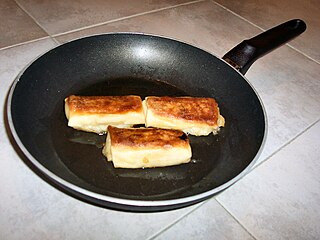 W
WA non-stick surface is a surface engineered to reduce the ability of other materials to stick to it. Non-stick cookware is a common application, where the non-stick coating allows food to brown without sticking to the pan. Non-stick is often used to refer to surfaces coated with polytetrafluoroethylene (PTFE), a well-known brand of which is Teflon. In the twenty-first century, other coatings have been marketed as non-stick, such as anodized aluminium, silica, enameled cast iron, and seasoned cookware.
 W
WNordic Ware is a company based in the Minneapolis, Minnesota, suburb of St. Louis Park, notable for introducing the Bundt cake pan in the early 1950s.
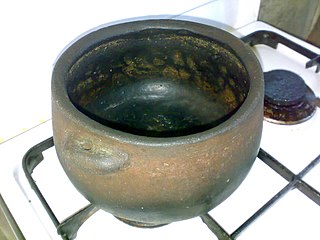 W
WA palayok is a clay pot used as the traditional food preparation container in the Philippines. Palayok is a Tagalog word; in other parts of the country, especially in the Visayas, it is called a kulon; smaller-sized pots are referred to as anglit. Neighboring Indonesia and Malaysia refer to such vessel as a periuk.
 W
WA pie bird, pie vent, pie whistle, pie funnel, or pie chimney is a hollow ceramic device, originating in Europe, shaped like a funnel, chimney, or upstretched bird with open beak used for supporting or venting a pie. Occasionally other whimsical shapes are used.
 W
WRevere Ware is a line of consumer and commercial kitchen wares introduced in 1939 by the Revere Brass & Copper Corp. The line focuses primarily on consumer cookware such as skillets, sauce pans, stock pots, and tea kettles. Initially Revere Ware was the culmination of various innovative techniques developed during the 1930s, the most popular being construction of stainless steel with rivetlessly attached bakelite handles, copper-clad bases and rounded interiors for ease of cleaning. Over the next 40+ years, Revere Ware would introduce new series to position itself in competition with other manufacturers at various price points, or for specific specialty markets. In the early 1960s the profitability of Revere Ware began to level off. Coinciding with new series introductions, cost-cutting measures were implemented in the manufacture of the traditional cookware. The bakelite handles were changed from two piece to one, and the thickness of utensil walls and copper cladding were reduced.
 W
WA rice cooker or rice steamer is an automated kitchen appliance designed to boil or steam rice. It consists of a heat source, a cooking bowl, and a thermostat. The thermostat measures the temperature of the cooking bowl and controls the heat. Complex, high-tech rice cookers may have sensors and other components, and may be multipurpose.
 W
WA rice polisher is a machine for buffing kernels of rice to change their appearance, taste, and texture or for transforming brown rice into white rice.
 W
WA rolling pin is a cylindrical food preparation utensil used to shape and flatten dough. Two styles of rolling pin are found: rollers and rods. Roller types consists of a thick cylinder with small handles at each end; rod type rolling pins are usually thin tapered batons. Rolling pins of different styles and materials offer varying advantages, as they are used for different tasks in cooking and baking.
 W
WA saucier or sauté chef is a position in the classical brigade style kitchen. It can be translated into English as sauce chef. In addition to preparing sauces, the saucier prepares stews, hot hors d'œuvres, and sautés food to order. Although it is often considered the highest position of the station cooks, the saucier is typically still tertiary to the chef and sous-chef.
 W
WSeasoning or curing is the process of coating the surface of cookware with a bioplastic formed from heated fat or oil in order to produce a heat, corrosion, and stick resistant hard coating. It is required for cast-iron cookware and carbon steel, which otherwise rust rapidly in use, but is also used for many other types of cookware, as it helps prevent food sticking.
 W
WA sheet pan, baking tray or baking sheet is a flat, rectangular metal pan used in an oven. It is often used for baking bread rolls, pastries and flat products such as cookies, sheet cakes, Swiss rolls and pizzas.
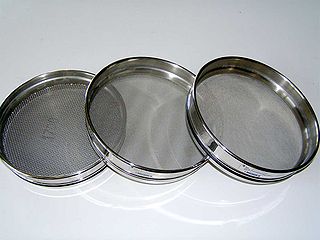 W
WA sieve, fine mesh strainer, or sift, is a device for separating wanted elements from unwanted material or for characterizing the particle size distribution of a sample, using a screen such as a woven mesh or net or perforated sheet material. The word "sift" derives from "sieve".
 W
WA splatter guard is a device placed over a frying pan to prevent hot oil from spitting out of the pan, which often happens when pan frying at a high temperature. This has two main purposes: droplets of hot oil can cause dangerous burns if they land on the skin, and, if they land elsewhere, can cause stains. Splatter guards are generally circular, so as to fit the shape of a frying pan, and have a handle for ease of removal and safety. They are normally made of a fine metal mesh or a metal sheet with numerous small holes, to allow steam to exit the pan but not oil. Other designs exist, such as the cone-shaped silicone Frywall, which allows for stirring and flipping while the food cooks.
 W
WA springform pan is a type of bakeware that features sides that can be removed from the base. Springform refers to the construction style of this pan. The base and the sides are separate pieces that are held together when the base is aligned with a groove that rings the bottom of the walls. The pan is then secured by a latch on the exterior of the wall. This tightens the 'belt' that becomes the walls of the pan and secures the base into the groove at the base of the walls.
 W
WStoneware is a rather broad term for pottery or other ceramics fired at a relatively high temperature. A modern technical definition is a vitreous or semi-vitreous ceramic made primarily from stoneware clay or non-refractory fire clay. Whether vitrified or not, it is nonporous ; it may or may not be glazed. Historically, across the world, it has been developed after earthenware and before porcelain, and has often been used for high-quality as well as utilitarian wares.
 W
WA tajine or tagine is a Berber dish, named after the earthenware pot in which it is cooked. It is also called maraq or marqa.
 W
WTapayan or tempayan are large wide-mouthed earthenware or stoneware jars found in various Austronesian cultures in island Southeast Asia. Their various functions include fermenting rice (tapai), fermenting vinegar or alcoholic beverages, storing food and water, cooking, and burial of the deceased.
 W
WA tortilla press is a traditional device with a pair of flat round surfaces of about 8-inch plus to crush balls of corn dough in order to obtain round corn tortillas or flour tortillas. Tortillas are pressed out between sheets of plastic or corn leaves. Tortilla presses are usually made of cast iron, cast aluminium or wood.
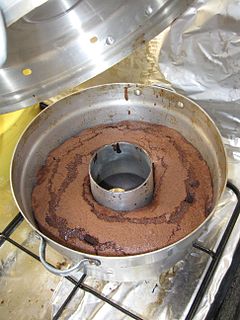 W
WWonder Pot is an Israeli invention for baking on top of a gas stove rather than in an oven. It consists of three parts: an aluminium pot shaped like a Bundt pan except smooth-sided rather than fluted, a hooded cover perforated with venting holes, and a thick, round, slightly domed metal disc with a center hole that is placed between the pot and the flame.